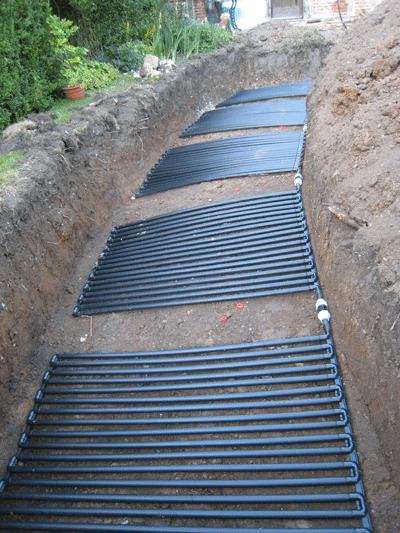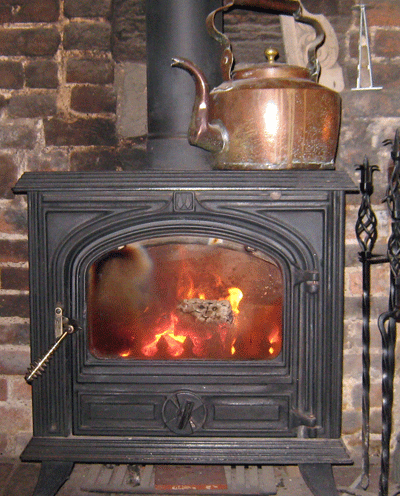Heat your period house for less
Using renewable energy to heat your house makes sense particularly if you’re in a period property

In previous blogs I've looked at how historic buildings are much more sustainable than they are generally considered to be. It is still true, however, that they are more difficult to heat than well constructed, modern buildings.
There are some very good reasons for this:
While insulation can be improved, it will not usually be possible to meet current building regulations without damaging historic fabric or compromising "breathability". Too much insulation can cause condensation within the structure, with potentially serious consequences for both building and occupants. Insulating a historic building requires extreme caution and should never be attempted without expert advice.
A historic building needs to be well ventilated - about twice as much as a modern house. This has an impact on heat retention. It therefore makes sense to consider renewable heat sources to reduce both cost and environmental impact.
There are special considerations to be taken into account, particularly for listed buildings and conservation areas. What is appropriate will depend on a particular building - one of the joys of historic buildings is that they are all different and need to be considered individually. Listed Building Consent, Planning Permission and Building Regulations approval may all be required.
Heatpumps
You may be surprised to learn that you have at least one heatpump in your house already. A fridge is a heatpump used for cooling. It is simply a matter of using the same technology in reverse to provide heating.
Sign up for the Country Life Newsletter
Exquisite houses, the beauty of Nature, and how to get the most from your life, straight to your inbox.

A groundsource heatpump extracts heat from the ground, using a long pipe filled with antifreeze solution. The drawback is that this can require quite a bit of space. An airsource heatpump draws air through a heat exchanger to extract heat from it. This may be a better option if space is limited but is less efficient, particularly in very cold weather.
The heatpump effectively concentrates heat to increase the temperature and heat water which is then pumped around a central heating circuit. To maximise efficiency, the heating circuit operates at a lower temperature (typically 40C to 60C) than conventional central heating. This results in a heating system which is more or less always on, rather than constantly switching on and off.
There is a body of opinion that considers heatpumps to be suitable only for very well insulated homes but they can work well in historic buildings, so long as they are not extremely draughty and poorly insulated (if your house is like that you need to do something about it anyway!). Constant, low temperature heating is more compatible with historic fabric than high temperature peaks and troughs. It takes advantage of their generally high thermal mass.
A heatpump uses electricity to operate but the energy (heat) output is much higher than it uses. Depending on circumstances, it can be between 2.5 and 5 times as much.
Biomass
Biomass is plant material used as fuel for your heating system. In practical terms this means wood, either in the form of logs or pellets made from waste wood or sawdust. Because it involves burning fuel to generate heat, it differs from other renewable options in producing emissions. However, because the CO2 produced is balanced by that taken up by the tree while it's growing, it can be considered carbon neutral. So long as the wood is sustainably produced it is a renewable resource. The use of waste product which would otherwise be consigned to landfill is even better.

There is a range of biomass options. A woodburning stove will provide space heating and may be adapted to provide hot water. At the other end of the scale, a large biomass boiler can provide hot water and heating in place of a conventional system.
Solar Thermal
In domestic terms this really means heating water using solar panels. This is a cost effective option, with low capital cost and high efficiency. In summer it can provide all your hot water requirements but in winter its benefit is in preheating water before it is brought up to temperature by an alternative system.
Often it's not possible to install panels on historic buildings because it will impact on their character. Where there are hidden roof slopes, modern extensions or outbuildings an appropriate location can sometimes be found. It's important to ensure both the strength of the roof and its orientation are suitable.
Photo-Voltaic Cells
PV cells generate electricity from sunlight and will provide renewable power for your home. Their limitations for use in historic buildings are similar to solar thermal panels but they can be sited more remotely from the house, so a stand-alone array may be possible if you have space out of sight of the building.
Mixing Technologies
These options shouldn't be considered in isolation - very often the best solution will be a combination. For example a heatpump may not keep the house up to temperature in very cold weather but will be effective with a woodburning stove as a supplementary heat source or the electricity used by a heatpump may be offset by generation from a PV array.
Alan Tierney is a historic building consultant and runs Picketts Historic Building Conservation, advising clients on all aspects of the care, maintenance and alteration of historic buildings. This includes working with homeowners to improve energy performance by sustainable means, while protecting the integrity and value of our precious resource of older buildings.

This is an article from ProjectBook which provides a wide range of information for the conservation, restoration, care and repair of period and listed buildings. Picketts Historic Building Conservation is a member of the Heritage Register which contains over 500 vetted craftsmen, contractors and consultants from all over the UK. Updated daily with new content, the website features the heritage register, a products directory, informative articles, current news, events and more. For more information, visit www.projectbook.co.uk
Country Life is unlike any other magazine: the only glossy weekly on the newsstand and the only magazine that has been guest-edited by HRH The King not once, but twice. It is a celebration of modern rural life and all its diverse joys and pleasures — that was first published in Queen Victoria's Diamond Jubilee year. Our eclectic mixture of witty and informative content — from the most up-to-date property news and commentary and a coveted glimpse inside some of the UK's best houses and gardens, to gardening, the arts and interior design, written by experts in their field — still cannot be found in print or online, anywhere else.
-
 From California to Cornwall: How surfing became a cornerstone of Cornish culture
From California to Cornwall: How surfing became a cornerstone of Cornish cultureA new exhibition at Cornwall's National Maritime Museum celebrates a century of surf culture and reveals how the country became a global leader in surf innovation and conservation.
By Emma Lavelle Published
-
 Jaecoo 7 SHS: Can you really get a luxury SUV for £35,000?
Jaecoo 7 SHS: Can you really get a luxury SUV for £35,000?The Chinese automaker Jaecoo lands on UK shores with the 7. We take it for a spin around Scotland and the north of England to see if the hype is real.
By Charlie Thomas Published

